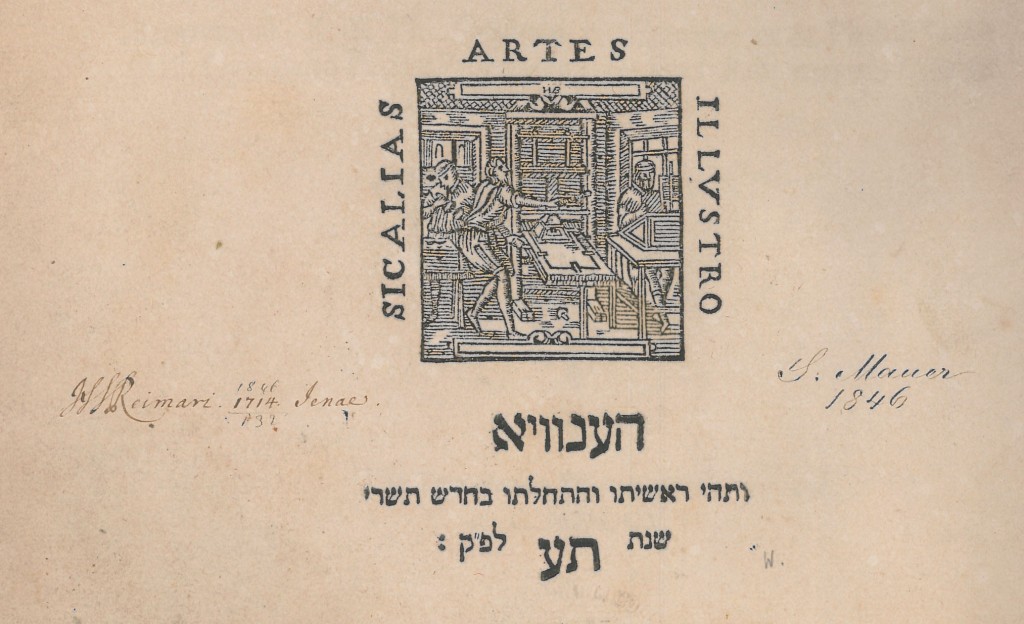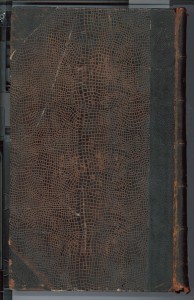Contrary to the common wisdom one may hear in archives, I have over the years discovered a basic truth about printed books. Every book with any history is a unique item. This past summer I had the opportunity to catalog a number of especially compelling items for the Cincinnati rare book collections.
A case in point involves three separate copies of a 1710 printing of Rabbi Isaac Abravanel’s (1437-1508) commentary on the Torah. One of them caught my eye immediately as it was in a contemporary binding. Note that I did not write “original” binding. The phenomenon of a book prepared and sold by a publisher in identical bound format is a phenomenon of the first quarter of the nineteenth century. At the beginning of the eighteenth century printing and binding were two separate trades. Generally one purchased one’s book in unfolded and unsewn sheets and then took the sheets to the binder of one’s choice. Bindings could vary even at the point of origin depending on material and price. The other two copies were rebound at HUC, likely at the time of acquisition. One is half bound in leather and decorated paper over pasteboards. The other is in a standard library cloth binding.
I will describe these books individually, beginning with that in the contemporary binding. Each is about thirty five centimeters in height, and approximately six centimeters thick, making them rather substantial. By comparison, most academic books today tend to be twenty three to twenty five centimeters in height. In two of the books a solitary leaf of the index was bound in towards the end of text rather than at its correct place. In my experience, such mistakes did occur and can add to the interest of the individual copy.
The volume in the contemporary binding is bound in parchment over pasteboards with edges stained in red, a rather common and utilitarian binding for such a book. This copy’s history of ownership is of particular interest. The book itself has a Christian editor, one Heinrich Jacob van Bashuysen (1679-ca. 1750), a professor in Hannover in northern Germany. Its history of ownership includes two Jews and two Christians.
The two Jews each signed the book in Hebrew as, respectively, Mosheh ben Lev Oppenheim, and Hananyeh ben Yitshak ben Lev Oppenheim, seemingly two generations of the same family. The two Christians signed in Latin script, the one as H. [Hermann] S. [Samuel] Reimari [Reimarus] [1694-1768] in 1714 in Jena, the other as S. Mauer, 1846. Reimarus is a famous philosopher and scholar of his time. He acquired his copy of the “Perush ha-Torah” as a student at the University of Jena. I have been unable to establish anything about either of the Oppenheims or about S. Mauer.
One of the owners added a ms. biography of Abravenel, “Vita Abarbanelis” to the upper free endpaper. This copy came to the Cincinnati library as a gift of Rabbi Max Landsberg (1845-1927), a noted American Reform scholar of his time.
The one in half bound leather and decorated paper came from the library of Rabbi Gotthard Deutsch (1859-1921), formerly an HUC faculty member.
 The third copy includes three contemporary Hebrew inscriptions. In more recent times it was part of the collection of the Lemle Moses Klaus-Stiftung in Mannheim, Germany. Rabbi Karl Richter (d. 2005), who came from Mannheim to the U.S. in 1939, presented the volume to the HUC library.
The third copy includes three contemporary Hebrew inscriptions. In more recent times it was part of the collection of the Lemle Moses Klaus-Stiftung in Mannheim, Germany. Rabbi Karl Richter (d. 2005), who came from Mannheim to the U.S. in 1939, presented the volume to the HUC library.
While the text of these three volumes can be said to be identical, each has a story to tell unique to itself.





